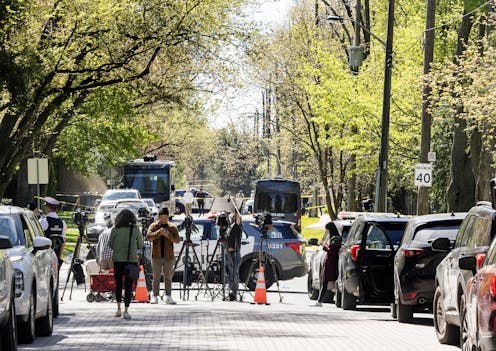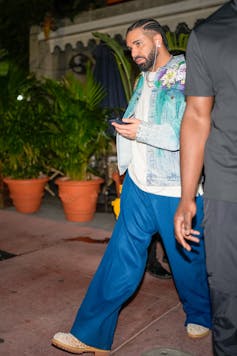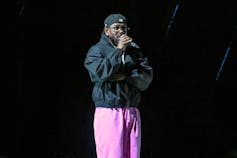Rap ‘beef’ as public spectacle is a dangerous game that artists rarely win
Since rap’s emergence, artists have boasted about themselves in ways that were funny and sometimes violent, vulgar and sexist. The popularity of the music and its exploitation can be dangerous.

The shooting of a security guard near the Toronto home of Drake is the latest chapter in the ongoing beef between the Canadian rapper and Pulitizer Prize-winning rival Kendrick Lamar.
Rap battles have historically been a way for emcees to display their lyrical superiority against one another through the art of the diss, or disrespect. True to the name, disses have always attempted wittiness by many means, including threats of violence and humor. Since hip-hop has become global, media and corporations have used the spectacle of violence – including rap battles – for financial gain.
In fact, shortly after the release of the song “Like That,” featuring a pointed, aggressive verse from Lamar, billboards appeared in New York and Los Angeles that read, “Hip-Hop is a competitive sport.”
These billboards were sponsored by Spotify and RapCaviar, the service that curates Spotify’s popular hip-hop playlist.
But the history of violence projected onto rappers and the profitability of their deaths suggest that Spotify and RapCaviar might have more to gain from stoking this conflict than the artists.
More people arguably sought the music of Tupac Shakur and Notorious B.I.G. after their tragic deaths in the late 1990s. Since then, rappers like Pop Smoke and Juice WRLD, to name a couple, became more popular after they died.
As a hip-hop artist who studies the ways Black art and Black people are exploited and erased from history, the widespread promotion of beef and conflicts between rappers is dangerous. Conflict may be lucrative for some parties, and it’s also unlikely to be eliminated from the culture, but Spotify’s invitation to view hip-hop as a competitive sport for its global audience makes it especially troublesome.
‘Battle royale’?
The feud between Lamar and Drake has been brewing for years and gained publicity in 2023 when Drake and J. Cole teamed up for the song “First-Person Shooter.”
On that song, Cole dismisses attempts by critics to pit the best-selling rappers against one another:
“Love when they argue the hardest emcee. / Is it K-Dot? Is it Aubrey? Or me? / We the big three like we started a league, / but right now, I feel like Muhammad Ali.”
Lamar apparently didn’t like the comparison. In a song released in March 2024, Kendrick tried to set himself apart from J. Cole and Drake on “Like That”: “Motherf–k the big three, n–ga, it’s just big me.”
Given the long histories of witty wordplay among rappers, it’s understandable that hip-hop fans are interested in who claims the crown as the best among their favorite rappers.
Longtime fans can recall the deftness with which Count Coolout described in exaggerated terms about make-believe universes where people rocked to the “disco-mania” of the 1980s in a place called “Rhythmvania.”
More famously, Roxanne Shanté kicked off “The Roxanne Wars” in 1984. The rap group “U.T.F.O.” wrote a song about a “stuck up” girl they called “Roxanne.” The then-14-year-old rapper took on the name and released her “Roxanne’s Revenge,” which proclaimed her superior rap skills.

Today’s disses continue a tradition that goes back to the earliest days of hip-hop, only now for a worldwide audience.
The current presentation of rap battles as public spectacle pits modern-day rappers like Drake and Lamar against one another in contests akin to what Ralph Ellison described as a “battle royale.”
In Ellison’s landmark novel, “Invisible Man,” wealthy white men gather a group of Black men and cheer them on to fight until only one is left standing. For his efforts, the winner receives a prize. But given what is required to win, it’s hard to say if he really won anything.
Diss tracks beyond rap
The flurry of diss songs and the media coverage of each salvo reveal something about the values of the artists, their audiences and the industry.
The disses that audiences have been eagerly consuming as each track is released include violence, victim-blaming for childhood assault, accusations of pedophilia, misogyny, homophobia and transphobia. While fans reward the disrespect with attention, and streaming and social media platforms make money, people who are vulnerable to the kinds of attacks the artists are using against one another are left to reckon with harmful words lobbed by global superstars and the “jokes” people are making in response.
The songs and media coverage also reveal how even perceived disses are being promoted in other musical genres and across cultures.
In Taylor Swift’s latest album, for instance, one of the songs on “The Tortured Poets Department” is rumored to be about the longstanding feud between Swift and Kim Kardashian and her former husband Ye (formerly Kanye West).
The rumors prompted Vogue to declare 2024 the “Year of the Diss Track.”

The diss has even made its way to the 2024 presidential election. President Joe Biden released an ad online dissing GOP rival Donald Trump. The ad shows Biden with Vice President Kamala Harris and has Kendrick rapping in the background:
“It’s always been about love and hate, now let me say I’m the biggest hater. / I hate the way that you walk, the way that you talk, / I hate the way that you dress./
But in politics and sports such as professional wrestling, trash talking is often understood by audiences and competitors as a performance and not reality.
In reality, if rap is viewed as a competitive sport akin to professional wrestling, and Spotify invites us to gawk at it, then rappers might be more like the replaceable items used to make the entertainment more exciting – the chair broken across someone’s head, the ring that wrestlers get slammed on or the turnbuckle against which an opponent’s face is smashed.
When something terrible ultimately happens, it’s barely considered a tragedy when they’re destroyed – and there’s not even a moment’s pause in the streaming of their music after they’re gone.
A.D. Carson does not work for, consult, own shares in or receive funding from any company or organization that would benefit from this article, and has disclosed no relevant affiliations beyond their academic appointment.
Read These Next
What’s at stake in Trump’s executive order aiming to curb state-level AI regulation
In the absence of comprehensive federal AI regulation, states have stepped in. The Trump administration,…
Data centers need electricity fast, but utilities need years to build power plants – who should pay?
How many data centers will be built – and how much electricity they’ll need – is uncertain. Being…
Whether Netflix or Paramount buys Warner Bros., entertainment oligopolies are back – bigger and mor
Hollywood has seen this movie before.





